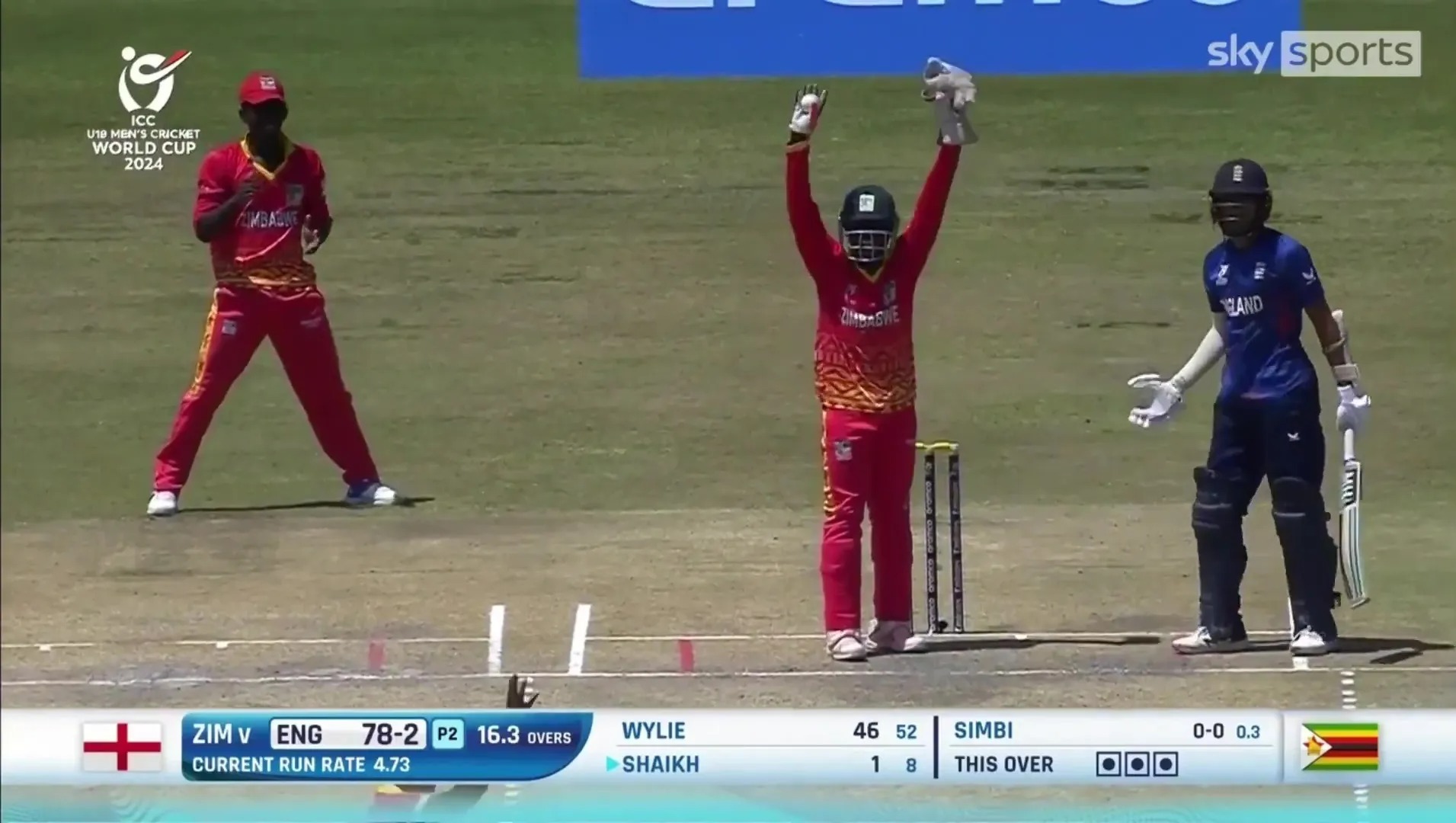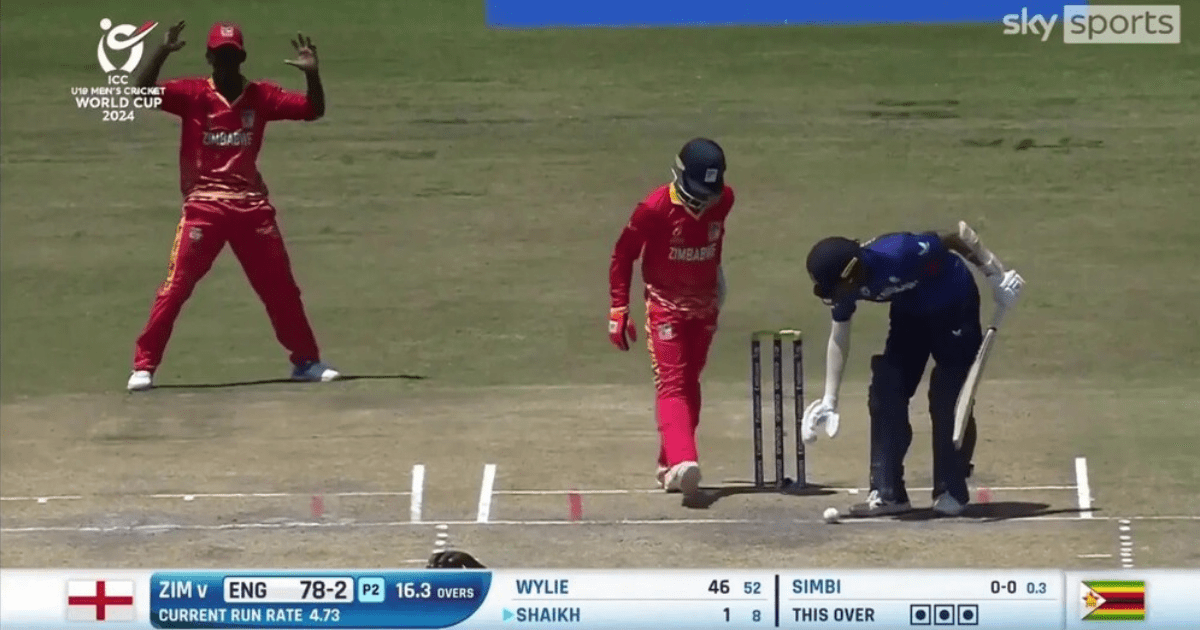Hamza Shaikh Falls Victim to Unusual Rule
Hamza Shaikh, a promising young cricketer representing England in the U19 World Cup, was given out for a highly unusual dismissal during a recent match against Zimbabwe. Batting at No.4, Shaikh was hoping to help his team set a formidable total for Zimbabwe to chase down.
A Shocking Decision Leaves Shaikh Stunned
After a solid start to the innings, Shaikh joined the crease with the score at 70/2. However, his time at the wicket was short-lived. On just his ninth ball, Shaikh swung at a delivery but failed to make meaningful contact. The ball settled between his legs on the wicket. In an attempt to save time, Shaikh picked up the stationary ball and threw it to Zimbabwean wicketkeeper Ryan Kamwemba. Little did Shaikh know that this action would lead to his dismissal.
Obstructing the Field: A Rare Rule
According to the laws of cricket, a player can be given out for obstructing the field if they use any part of their person to give the ball back without the consent of a fielder. Kamwemba, seizing the opportunity, appealed for Shaikh to be out for obstructing the field. Much to Shaikh's surprise, the umpire agreed and raised his finger.
Controversy Erupts and Fans React
The decision to give Shaikh out sparked controversy and a flurry of reactions on social media. Former England fast bowler Steve Harmison criticized the decision, exclaiming that "the game's gone" in his commentary. Fans echoed Harmison's sentiments, with one calling the decision "horrific" and another stating, "That's not cricket."

A Rare Dismissal with Limited Instances
Shaikh's dismissal for obstructing the field is one of the nine ways a batter can be dismissed in cricket. However, it has only occurred eight times in Men's One Day Internationals. The most recent example was Sri Lanka's Danushka Gunathilaka against the West Indies in March 2021. England's Ben Stokes has also experienced this dismissal, falling victim to it against Australia in 2015. Since 1951, there have been only 23 recorded dismissals of this type in all formats, including Women's ODIs.
England Recovers and Seals Victory
Despite the shock dismissal, England bounced back and posted a total of 237/7 from their allotted 50 overs. They then proceeded to dismiss the Zimbabwean team for just 91 runs, securing a convincing 146-run win. However, both teams had already been eliminated from the semi-final stage due to losses against West Indies and Australia.
England's journey in the 2022 U19 World Cup ended with a loss to India in the final.
Frequently Asked Questions
How can I be sure that my cricket pads fit correctly?
Cricket pads that fit properly are essential for both protection and mobility. The pads’ top should reach to the bottom of your thigh. You want the knee to be comfortably placed in the center. Straps need to fit snugly but not restrict circulation. Wearing them should allow you to move around freely and comfortably.
How can I find the right cricket balls?
What level of cricket are you playing will determine what cricket ball is best for you. Leather balls are recommended for competitive games. For training or casual games, you might consider a softer synthetic ball. To prevent injuries, junior players should use lighter balls. Verify the specifications of balls in league regulations.
Can I use a Tennis Ball for Cricket Practice?
While tennis balls are not recommended for formal games of cricket, they can be very useful in casual practice. This is particularly true for beginners, or for playing in tight spaces where a hard ball could damage or cause injury. You can use it to improve your batting, catching and fielding skills.
What is the difference between the grades of willow used in cricket bats and which one should I buy?
The willow used to make cricket bats is either English or Kashmir. English willow comes in grades ranging from Grade 1, the best quality, with straight grains, and Grade 4, the worst, with irregular grains, and more blemishes. Choose according to the level of your play and your budget. Competitive players should invest in a higher grade for better performance, while casual players may opt for lower grades.
Statistics
- It is estimated that a well-maintained cricket bat can last for around 1000 hours of play, whereas neglected bats might last only a third of that time.
- Lightweight cricket shoes can improve running speed on the field by up to 15% for some players.
- Studies show that leather cricket balls can deteriorate up to 30% in performance after 80 overs of play.
- Around 70% of cricket-related injuries could be prevented with the proper use of protective gear.
- Nearly 85% of cricketers agree that the choice of grip significantly affects their batting comfort and control.
- Nearly 50% of amateur cricketers have experienced equipment-related discomfort or injury due to improper fitting.
- Approximately 80% of junior cricketers use bats that are too heavy, potentially affecting their technique and performance.
- Close to 60% of cricket players report improved batting performance after selecting a bat with the correct size and weight.
External Links
pitchvision.com
gray-nicolls.co.uk
sportskeeda.com
sportsuncle.com
decathlon.in
playerstowel.com
kookaburra.biz
amazon.in
How To
How to Understand Cricket Bat Grains
The grains can give you a clue as to the age and quality of a bat. A bat that has 6-12 straight grain is usually a mature, high-quality willow. A bat with more grains is usually softer, quicker to play and has a longer life. Fewer grains can indicate a tougher bat, which might be more difficult to ‘knock-in’ at first but will last longer.
Did you miss our previous article…
https://www.sportingexcitement.com/cricket/from-garden-centre-to-cricketing-hero-the-rise-of-englands-tom-hartley/

